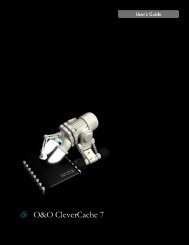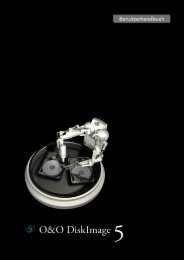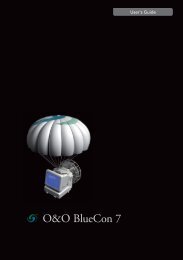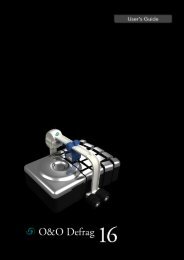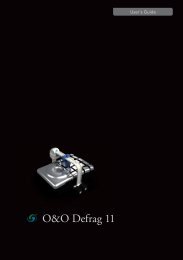O&O DiskImage 7 User's Guide - O&O Software
O&O DiskImage 7 User's Guide - O&O Software
O&O DiskImage 7 User's Guide - O&O Software
You also want an ePaper? Increase the reach of your titles
YUMPU automatically turns print PDFs into web optimized ePapers that Google loves.
Settings for drive imaging<br />
Ignore bad sectors<br />
You can specify under Drive imaging/Imaging options/Advanced whether the read process should be aborted or continued<br />
in case of error. If continued, the bad sector will be saved in the image as an unused sector. The remaining data<br />
that is still readable will then be available in the image.<br />
• Enable the check for Ignore and automatically skip bad sectors while reading.<br />
Data comparison with checksums<br />
Unchanged data resulting from incremental images is saved using checksums by default. Such a file will be slightly<br />
larger. That's why it's enough, when creating the next incremental image, to use an existing incremental image (with<br />
checksums) as the base image. This function is activated by default. If you save all images in a single folder, you can<br />
deactivate this function. Your images will then take up less space on disk.<br />
• Please make sure that the function Use checksums to administer unchanged data under Drive imaging/Imaging<br />
options/Advanced is enabled.<br />
Use profiles for drive imaging<br />
Under Drive imaging/Imaging options/Current profile you can reset current settings to Default, or select an already<br />
existing profile.<br />
Under Current profile you can select a preset Multimedia or Archive profile. The Multimedia profile automatically<br />
excludes already compressed music and video data (i.e. *.avi, *.mp3, *.mpeg) from the compression. The Archive Profile<br />
excludes other compressed data such as *.zip or *.rar.<br />
If you would like to save your user-defined settings, please follow these instructions:<br />
1. Enable your settings under Drive imaging/Imaging options.<br />
2. Select under Save as....<br />
3. Give your newly created profile a name in the dialog window and confirm.<br />
4. Under Manage profiles you can change or delete an existing profile.<br />
O&O <strong>DiskImage</strong>-35



